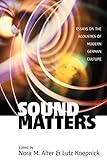Sound Matters : Essays on the Acoustics of German Culture / ed. by Lutz Koepnick, Nora M. Alter.
Material type: TextPublisher: New York ; Oxford : Berghahn Books, [2004]Copyright date: ©2004Description: 1 online resource (266 p.)Content type:
TextPublisher: New York ; Oxford : Berghahn Books, [2004]Copyright date: ©2004Description: 1 online resource (266 p.)Content type: - 9781571814371
- 9781782381723
- 780.1 23
- ML3845 .S686 2006
- online - DeGruyter
| Item type | Current library | Call number | URL | Status | Notes | Barcode | |
|---|---|---|---|---|---|---|---|
 eBook
eBook
|
Biblioteca "Angelicum" Pont. Univ. S.Tommaso d'Aquino Nuvola online | online - DeGruyter (Browse shelf(Opens below)) | Online access | Not for loan (Accesso limitato) | Accesso per gli utenti autorizzati / Access for authorized users | (dgr)9781782381723 |
Frontmatter -- CONTENTS -- Acknowledgments -- Introduction: Sound Matters -- Part I: Sound Nation? -- 1. Hegemony through Harmony: German Identity, Music, and Enlightenment around 1800 -- 2. Mahler contra Wagner: The Third Symphony and the Political Legacy of Romanticism -- 3. Conducting Music, Conducting War: Nazi Germany as an Acoustic Experience -- Part II: Dissonant Visions -- 4. The Politics and Sounds of Everyday Life in Kuhle Wampe -- 5. Sound Money: Aural Strategies in Rolf Thiele’s The Girl Rosemarie -- 6. The Castrato’s Voices: Word and Flesh in Fassbinder’s In a Year of Thirteen Moons -- Part III: Sounds of Silence -- 7. Benjamin’s Silence -- 8. Deafening Sound and Troubling Silence in Volker Schlöndorff’s Die Blechtrommel -- 9. Silence Is Golden? The Short Fiction of Pieke Biermann -- Part IV: Translating Sound -- 10. Broadcasting Wagner: Transmission, Dissemination, Translation -- 11. Sounds Familiar? Nina Simone’s Performances of Brecht/Weill Songs -- 12. Roll Over Beethoven! Chuck Berry! Mick Jagger! 1960s Rock, the Myth of Progress, and the Burden of National Identity in West Germany -- 13. The Music That Lola Ran To -- Part V: Memory, Music, and the Postmodern -- 14. “Heiner Müller vertonen”: Heiner Goebbels and the Music of Postmodern Memory -- 15. The Technological Subject: Music, Media, and Memory in Stockhausen’s Hymnen -- Notes on Contributors -- Index
restricted access online access with authorization star
http://purl.org/coar/access_right/c_16ec
The sounds of music and the German language have played a significant role in the developing symbolism of the German nation. In light of the historical division of Germany into many disparate political entities and regional groups, German artists and intellectuals of the 19th and early 20th centuries conceived of musical and linguistic dispositions as the nation's most palpable common ground. According to this view, the peculiar sounds of German music and of the German language provided a direct conduit to national identity, to the deepest recesses of the German soul. So strong is this legacy of sound is still prevalent in modern German culture that philosopher Peter Sloterdijk, in a recent essay, did not even hesitate to describe post-wall Germany as an "acoustical body." This volume gathers the work of scholars from the US, Germany, and the United Kingdom to explore the role of sound in modern and postmodern German cultural production. Working across established disciplines and methodological divides, the essays of Sound Matters investigate the ways in which texts, artists, and performers in all kinds of media have utilized sonic materials in order to enforce or complicate dominant notions of German cultural and national identity.
Mode of access: Internet via World Wide Web.
In English.
Description based on online resource; title from PDF title page (publisher's Web site, viewed 25. Jun 2024)


